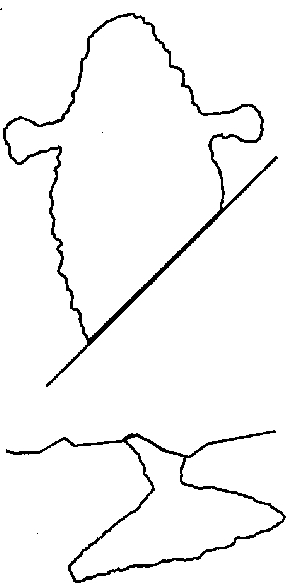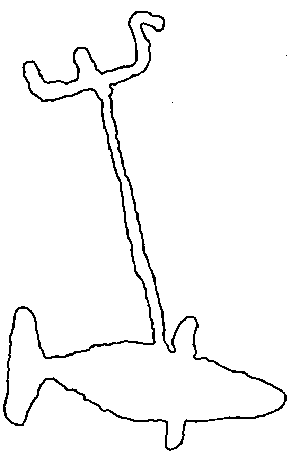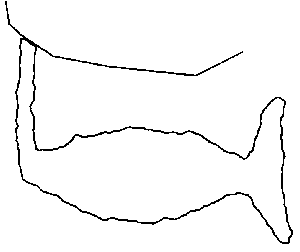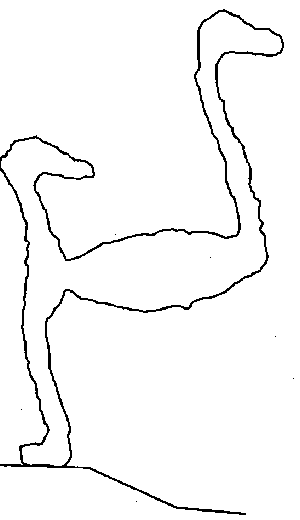



by Väino Poikalainen, Estonia: Prehistoric Sanctuary at Lake Onega
The main part of the Besov Nos carvings have been found at the western sector of the site. It is located close to the center of the cape point and consists of 144 petroglyphs. The bedrock here has many color anomalies, cracks and upheavals which makes the place very attractive. Descriptions from previous centuries tell about the hollow sound coming from the inside of the rock when working around it. Some visitors believe it is the work of the "Devil" - the central figure of the panel which is bisected by a rift (Fig. 31). Probably this split was a place for sacrifice before the Devil was made. It can be distinguished from the location of the figure and from the groove-like treatment made at the split.
The bedrock of the site has cracked into several parts causing the groups to appear as several distinct collections. The height of the carvings lies between 67-233 cm above the water level. A great deal of the lower petroglyphs can be seen very wel due to the russet color of the rock varnish. Higher images are situated on gray rocks on which lichens grow and are, thus, hard to observe. The rocks of all carving sites at Lake Onega and especially at the western point of Besov Nos have to withstand mighty pressures from the pack-ice in winter which has an impact on the surface and causes some loss of bedrock from time to time. It is one probable reason for the great number of partially preserved carvings here (Fig. 32). The other side some of the petroglyphs seem to be done with the ruptures and cracks in mind. (Fig. 33). Good examples of this phenomenon are the swan necks arising from the fissure close to the "Devil" (Fig. 8).
The size of the carvings is considerably large: 42% of them are less than 25 cm, the measure of 50 cm is exceeded by 21%. The most numerous topic are waterfowl figures which form 59% of the total. The second most common groups are anthropomorphs with 8%, and animal-like carvings with 9% (from which elkand deer-like petroglyphs are excluded) and unique petroglyphs with 7%. Lunar and solar signs seemed to be forbidden here because only one 5 cm tiny disc has been recently found high above the other carvings.
The central figure of the panel: "Devil" (in Russian: "Bes_) has given the contemporary name to the cape, peninsula and to the village on the hill. Thus it has been known to local inhabitants for a very long time. Unfortunately none of the legends connected with the carvings have survived. The petroglyphs have been known also to the monks of the nearby Muromski monastery about 30 km to the south. This was established to help fight the "pagan" beliefs and, also, to establish Christianity in the region. The monks have constructed an orthodox cross on the left hand of "Devil" christening it in such a way some 500 years ago. The same procedure has been carried out on one of the swans. Surprisingly these are the only visible traces
of actions against the carvings as representatives of pagan beliefs from the side of monks. Also local inhabitants have a history of holding the carvings in respect. Apparently the fear of revenge for anyone who harms the "Devil" disappeared much later. Only in 1934 the first letters were hewed into the rock. Now such vandalism has become a serious problem within the rock art territory.
"Devil" has been considered by Linevski and Stolyar as the very first carving of Lake Onega. Ravdonikas presumed this 2.5 meter long image to be one of the latest as it embodies traces of metal tool. It is accompanied by two other large carvings: an "Otter" of 2.6 m size, 2.7 m long "Catfish==Sheatfish", and a variety of smaller petroglyphs. Stolyar's opinion is that the huge figures are the projections of wooden idols against the rock surface. Linevski interpreted the "Devil" as the Master of the land, the woods and any unfavorable winds. Otter symbolized the wickedness, Sheatfish goodness and the smaller figures are regarded as symbolic sacrifices brought to the other figures. Laushkin regarded the western panel of Besov Nos as a place to worship deceased ancestors. "Devil" is actually female mistress of "The World of Dead" known also from the Finnish epic "Kalevala" as Tuonela and the whole triad of large carvings incarnate Death in its different embodiments. She is accompanied not by sheatfish but burbot and by a lizard (not otter) as personifications of aversion and horror. In his own interpretations, Laushkin has used only a scanty amount of local folklore about rock art. One story tells about the "Devils" wife Besikha, who wanted to carry away the whole cape at night. But the job was hard and at dawn she was interrupted by the crow of a cock. As "proof" of her work, one need only look at the geography of the cape with its long shape and a rocky island 200 m away from its point. Ernits has developed another interpretation for the "Devil". He considers it the Goddess of the Rock (Land) giving birth to prosperity for local tribes. The Otter and Sheatfish might represent the Mother of Animals and the Mother of Fishes respectively.
One peculiarity of Besov Nos carvings is the abundance of unique petroglyphs. Also common figures here have unique features which has brought on still more discussion about the meaning. One most beautiful row of silhouetted swans on the north-western part of the panel starts with a human- like creature and consists of a swan which carries a specific depiction that resembles a tent with vertical short line in the center. This line has become a key for Stolyar in his interpretation of the composition. It represents the soul of a human on his way to the realm of dead assisted by swans (Fig. 34). The aim of the journey is to reach the boat of his ancestors which ends the swan row.
Swan features can be quite usually distinguished from the human-like figures of Besov Nos. These depict probably the totemic ancestors of swan-tribe people. Also the little anthropomorph at the beginning of swan row has a waterfowl head. More clearly this feature could be seen at the bigger phallistic figure of the same group. Another phallistic human has a waterfowl depiction on its head. This was interpreted by Laushkin as the God of Fertility whose attribute is the swan utilized as a mark on a newborn child spirit. In a nearby carving group the central swan figure has a leg which resembles a human leg. At fantastic combination of swan with human is the southern-most carving of the panel. Here the realistic swan depiction has been combined with the separate parts of human body: the hand, head and phallus (Fig. 10) . Among other human-like creatures there is an anthropomorph which has a big elk-head with unique antlers and only two parallel curved lines to represent human features. Because it looks so unlike a human it has been considered to be an unfinished elk by Burkitt and a net for fish by Linevski.
Of special attention here are the depictions of whale-like creatures of the site. They have been for a long time considered to be fishes. One of them harpooned from a small boat has been interpreted by Laushkin as mythological scene with the fish from the realm of the deceased. Savvateyev identified these carvings as lake seals habituating in Lake Ladoga and Saimaa. Accordingly to experts of geology and biology the whales have never lived in Onega. But likeness of these carvings to the whales (or dolphins) is so obvious that there couldn't be any doubt about the prototype animal. This indicates the tight connections between the neolithic tribes of Lake Onega and the White Sea where whale depictions are widely spread. In addition, two of whale- like carvings carry swan features. From the nose of one whale a waterfowl neck stretches out which makes the animal more like a swan. Another depicts a swan with a long body and whale tail forming partly the neck of another swan arising from the rupture in the bedrock (Fig. 354). If these carvings represent the coalition of different totems, the prehistoric migration conceptions of Karelia needs some supplementation.
Cape Kladovets is situated 1.3 km from the western point of Besov Nos to the South-East. It is 120 m wide and is goes 250 m into the lake. Kladovets (Russian "klad" means treasure) is rich in the prehistoric settlements. The placement of them has shown that in Mesolithic time and during the transgression of the water at the end of Stone Age this cape has been an island. There are 41 carvings along its western coastline at the height of 60-196 cm. 37 of them are in a compact cluster at the center of the costal rock. Red varnish on the rock surface makes most of the low pecked petroglyphs very visible. The main group includes some badly damaged and hardly visible unidentified images on the higher part of the gray bedrock. The rest of the carvings are situated far away from the main group. One solar sign with two rays 50 m to the North and two small birds and a disc at about the same distance to the South-East.


